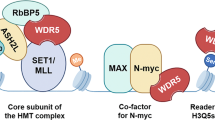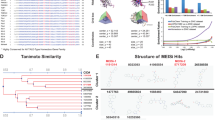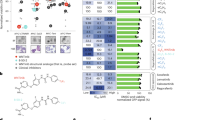Abstract
The Wnt/β-catenin signaling pathway has a crucial role in embryonic development, stem cell maintenance and human disease. By screening a synthetic chemical library of lycorine derivatives, we identified 4-ethyl-5-methyl-5,6-dihydro-[1,3]dioxolo[4,5-j]phenanthridine (HLY78) as an activator of the Wnt/β-catenin signaling pathway, which acts in a Wnt ligand–dependent manner. HLY78 targets the DIX domain of Axin and potentiates the Axin–LRP6 association, thus promoting LRP6 phosphorylation and Wnt signaling transduction. Moreover, we identified the critical residues on Axin for HLY78 binding and showed that HLY78 may weaken the autoinhibition of Axin. In addition, HLY78 acts synergistically with Wnt in the embryonic development of zebrafish and increases the expression of the conserved hematopoietic stem cell (HSC) markers, runx1 and cmyb, in zebrafish embryos. Collectively, our study not only provides new insights into the regulation of the Wnt/β-catenin signaling pathway by a Wnt-specific small molecule but also will facilitate therapeutic applications, such as HSC expansion.
This is a preview of subscription content, access via your institution
Access options
Subscribe to this journal
Receive 12 print issues and online access
$259.00 per year
only $21.58 per issue
Buy this article
- Purchase on Springer Link
- Instant access to full article PDF
Prices may be subject to local taxes which are calculated during checkout






Similar content being viewed by others
Accession codes
References
Clevers, H. & Nusse, R. Wnt/β-catenin signaling and disease. Cell 149, 1192–1205 (2012).
Zimmerman, Z.F., Moon, R.T. & Chien, A.J. Targeting Wnt pathways in disease. Cold Spring Harb. Perspect. Biol. 4, a008086 (2012).
Zeng, X. et al. A dual-kinase mechanism for Wnt co-receptor phosphorylation and activation. Nature 438, 873–877 (2005).
Li, V.S. et al. Wnt signaling through inhibition of β-catenin degradation in an intact Axin1 complex. Cell 149, 1245–1256 (2012).
Salic, A., Lee, E., Mayer, L. & Kirschner, M.W. Control of β-catenin stability: reconstitution of the cytoplasmic steps of the wnt pathway in Xenopus egg extracts. Mol. Cell 5, 523–532 (2000).
Lee, E., Salic, A., Kruger, R., Heinrich, R. & Kirschner, M.W. The roles of APC and Axin derived from experimental and theoretical analysis of the Wnt pathway. PLoS Biol. 1, E10 (2003).
Lamoral-Theys, D. et al. Lycorine, the main phenanthridine Amaryllidaceae alkaloid, exhibits significant antitumor activity in cancer cells that display resistance to proapoptotic stimuli: an investigation of structure-activity relationship and mechanistic insight. J. Med. Chem. 52, 6244–6256 (2009).
Chattopadhyay, U., Chaudhuri, L., Das, S., Kumar, Y. & Ghosal, S. Activation of lymphocytes by lycorine-1-O-β-D-glucoside. Pharmazie 39, 855–856 (1984).
Jho, E.H. et al. Wnt/β-catenin/Tcf signaling induces the transcription of Axin2, a negative regulator of the signaling pathway. Mol. Cell Biol. 22, 1172–1183 (2002).
Niida, A. et al. DKK1, a negative regulator of Wnt signaling, is a target of the β-catenin/TCF pathway. Oncogene 23, 8520–8526 (2004).
Chamorro, M.N. et al. FGF-20 and DKK1 are transcriptional targets of β-catenin and FGF-20 is implicated in cancer and development. EMBO J. 24, 73–84 (2005).
Zeng, W. et al. naked cuticle encodes an inducible antagonist of Wnt signalling. Nature 403, 789–795 (2000).
Klein, P.S. & Melton, D.A. A molecular mechanism for the effect of lithium on development. Proc. Natl. Acad. Sci. USA 93, 8455–8459 (1996).
Liu, C. et al. Control of β-catenin phosphorylation/degradation by a dual-kinase mechanism. Cell 108, 837–847 (2002).
Luo, W. & Lin, S.C. Axin: a master scaffold for multiple signaling pathways. Neurosignals 13, 99–113 (2004).
Morris, G.M. et al. AutoDock4 and AutoDockTools4: automated docking with selective receptor flexibility. J. Comput. Chem. 30, 2785–2791 (2009).
Schwarz-Romond, T. et al. The DIX domain of Dishevelled confers Wnt signaling by dynamic polymerization. Nat. Struct. Mol. Biol. 14, 484–492 (2007).
Erter, C.E., Wilm, T.P., Basler, N., Wright, C.V. & Solnica-Krezel, L. Wnt8 is required in lateral mesendodermal precursors for neural posteriorization in vivo. Development 128, 3571–3583 (2001).
Lekven, A.C., Thorpe, C.J., Waxman, J.S. & Moon, R.T. Zebrafish wnt8 encodes two wnt8 proteins on a bicistronic transcript and is required for mesoderm and neurectoderm patterning. Dev. Cell 1, 103–114 (2001).
Szeto, D.P. & Kimelman, D. Combinatorial gene regulation by Bmp and Wnt in zebrafish posterior mesoderm formation. Development 131, 3751–3760 (2004).
Davidson, A.J. et al. cdx4 mutants fail to specify blood progenitors and can be rescued by multiple hox genes. Nature 425, 300–306 (2003).
Ramel, M.C., Buckles, G.R., Baker, K.D. & Lekven, A.C. WNT8 and BMP2B co-regulate non-axial mesoderm patterning during zebrafish gastrulation. Dev. Biol. 287, 237–248 (2005).
Trowbridge, J.J., Moon, R.T. & Bhatia, M. Hematopoietic stem cell biology: too much of a Wnt thing. Nat. Immunol. 7, 1021–1023 (2006).
North, T.E. et al. Prostaglandin E2 regulates vertebrate haematopoietic stem cell homeostasis. Nature 447, 1007–1011 (2007).
Huang, S.M. et al. Tankyrase inhibition stabilizes axin and antagonizes Wnt signalling. Nature 461, 614–620 (2009).
Mao, J. et al. Low-density lipoprotein receptor-related protein-5 binds to Axin and regulates the canonical Wnt signaling pathway. Mol. Cell 7, 801–809 (2001).
Fiedler, M., Mendoza-Topaz, C., Rutherford, T.J., Mieszczanek, J. & Bienz, M. Dishevelled interacts with the DIX domain polymerization interface of Axin to interfere with its function in down-regulating β-catenin. Proc. Natl. Acad. Sci. USA 108, 1937–1942 (2011).
Sakanaka, C. & Williams, L.T. Functional domains of axin. Importance of the C terminus as an oligomerization domain. J. Biol. Chem. 274, 14090–14093 (1999).
Hsu, W., Zeng, L. & Costantini, F. Identification of a domain of Axin that binds to the serine/threonine protein phosphatase 2A and a self-binding domain. J. Biol. Chem. 274, 3439–3445 (1999).
Luo, W. et al. Axin contains three separable domains that confer intramolecular, homodimeric, and heterodimeric interactions involved in distinct functions. J. Biol. Chem. 280, 5054–5060 (2005).
Liu, Y.T. et al. Molecular basis of Wnt activation via the DIX domain protein Ccd1. J. Biol. Chem. 286, 8597–8608 (2011).
Chen, T. et al. Identification of zinc-finger BED domain-containing 3 (Zbed3) as a novel Axin-interacting protein that activates Wnt/β-catenin signaling. J. Biol. Chem. 284, 6683–6689 (2009).
Bilic, J. et al. Wnt induces LRP6 signalosomes and promotes dishevelled-dependent LRP6 phosphorylation. Science 316, 1619–1622 (2007).
Kim, S.E. et al. Wnt stabilization of β-catenin reveals principles for morphogen receptor-scaffold assemblies. Science 340, 867–870 (2013).
Congdon, K.L. et al. Activation of Wnt signaling in hematopoietic regeneration. Stem Cells 26, 1202–1210 (2008).
Reya, T. et al. A role for Wnt signalling in self-renewal of haematopoietic stem cells. Nature 423, 409–414 (2003).
Trowbridge, J.J., Xenocostas, A., Moon, R.T. & Bhatia, M. Glycogen synthase kinase-3 is an in vivo regulator of hematopoietic stem cell repopulation. Nat. Med. 12, 89–98 (2006).
Goessling, W. et al. Genetic interaction of PGE2 and Wnt signaling regulates developmental specification of stem cells and regeneration. Cell 136, 1136–1147 (2009).
Clément-Lacroix, P. et al. Lrp5-independent activation of Wnt signaling by lithium chloride increases bone formation and bone mass in mice. Proc. Natl. Acad. Sci. USA 102, 17406–17411 (2005).
Engler, T.A. et al. Substituted 3-imidazo[1,2-a]pyridin-3-yl- 4-(1,2,3,4-tetrahydro-[1,4]diazepino-[6,7,1-hi]indol-7-yl)pyrrole-2,5-diones as highly selective and potent inhibitors of glycogen synthase kinase-3. J. Med. Chem. 47, 3934–3937 (2004).
Graham, J.A. et al. Suppressive regulatory T cell activity is potentiated by glycogen synthase kinase 3β inhibition. J. Biol. Chem. 285, 32852–32859 (2010).
Youssef, D.T. Alkaloids of the flowers of Hippeastrum vittatum. J. Nat. Prod. 64, 839–841 (2001).
Li, L. et al. Dishevelled proteins lead to two signaling pathways. Regulation of LEF-1 and c-Jun N-terminal kinase in mammalian cells. J. Biol. Chem. 274, 129–134 (1999).
Li, Z., Nie, F., Wang, S. & Li, L. Histone H4 Lys 20 monomethylation by histone methylase SET8 mediates Wnt target gene activation. Proc. Natl. Acad. Sci. USA 108, 3116–3123 (2011).
Oxtoby, E. & Jowett, T. Cloning of the zebrafish krox-20 gene (krx-20) and its expression during hindbrain development. Nucleic Acids Res. 21, 1087–1095 (1993).
Ding, Y. et al. Caprin-2 enhances canonical Wnt signaling through regulating LRP5/6 phosphorylation. J. Cell Biol. 182, 865–872 (2008).
Wiśniewski, J.R., Zougman, A., Nagaraj, N. & Mann, M. Universal sample preparation method for proteome analysis. Nat. Methods 6, 359–362 (2009).
Deeb, S.J., D'Souza, R.C., Cox, J., Schmidt-Supprian, M. & Mann, M. Super-SILAC allows classification of diffuse large B-cell lymphoma subtypes by their protein expression profiles. Mol. Cell Proteomics 11, 77–89 (2012).
Cox, J. & Mann, M. MaxQuant enables high peptide identification rates, individualized p.p.b.-range mass accuracies and proteome-wide protein quantification. Nat. Biotechnol. 26, 1367–1372 (2008).
Cox, J. et al. Andromeda: a peptide search engine integrated into the MaxQuant environment. J. Proteome Res. 10, 1794–1805 (2011).
Abdiche, Y., Malashock, D., Pinkerton, A. & Pons, J. Determining kinetics and affinities of protein interactions using a parallel real-time label-free biosensor, the Octet. Anal. Biochem. 377, 209–217 (2008).
Acknowledgements
We greatly appreciate the gift of LRP6 and MESD plasmids from X. He (Boston Children's Hospital), and we thank the Zebrafish Core Facility–Shanghai Institute of Biochemistry and Cell Biology for providing zebrafish embryos. This work is supported by the Ministry of Science and Technology of China (grant 2010CB912100 to L.L., 2011CB966300 to X.S. and 2013CB910900 to W.P.) and the National Natural Science Foundation of China (grants 30930052 and 31230044 to L.L. and 30830114 to X.H.).
Author information
Authors and Affiliations
Contributions
S.W. designed, performed and analyzed biochemical, zebrafish and cell culture experiments. J.Y., D.C. and L.W. designed and performed chemical synthesis under the guidance of X.H. F.N. performed zebrafish embryo experiments. X.S. provided bioinformatics support. C.J. and W.M. performed the embryonic stem cell assays under the guidance of W.P. C.F. provided Flag-tagged Axin-stable HEK293T cells. S.X. and H.M. purified proteins. C.L. performed MS experiments under R.Z.'s guidance. S.W., C.F., W.P., X.S. and L.L. wrote the manuscript with advice from all of the authors. L.L. guided all of the aspects of this study.
Corresponding authors
Ethics declarations
Competing interests
The authors declare no competing financial interests.
Supplementary information
Supplementary Text and Figures
Supplementary Results, Supplementary Figures 1-23, Supplementary Tables 1-4 and Supplementary Notes. (PDF 7650 kb)
Supplementary Data Set 1
Supplementary Dataset 1 (XLS 979 kb)
Rights and permissions
About this article
Cite this article
Wang, S., Yin, J., Chen, D. et al. Small-molecule modulation of Wnt signaling via modulating the Axin-LRP5/6 interaction. Nat Chem Biol 9, 579–585 (2013). https://doi.org/10.1038/nchembio.1309
Received:
Accepted:
Published:
Issue Date:
DOI: https://doi.org/10.1038/nchembio.1309
This article is cited by
-
The scaffold protein AXIN1: gene ontology, signal network, and physiological function
Cell Communication and Signaling (2024)
-
Sevoflurane induces microRNA-18a to delay rat neurodevelopment via suppression of the RUNX1/Wnt/β-catenin axis
Cell Death Discovery (2022)
-
UCHL5 controls β-catenin destruction complex function through Axin1 regulation
Scientific Reports (2022)
-
Detection of candidate gene networks involved in resistance to Sclerotinia sclerotiorum in soybean
Journal of Applied Genetics (2022)
-
Wnt/β-catenin signaling in cancers and targeted therapies
Signal Transduction and Targeted Therapy (2021)



